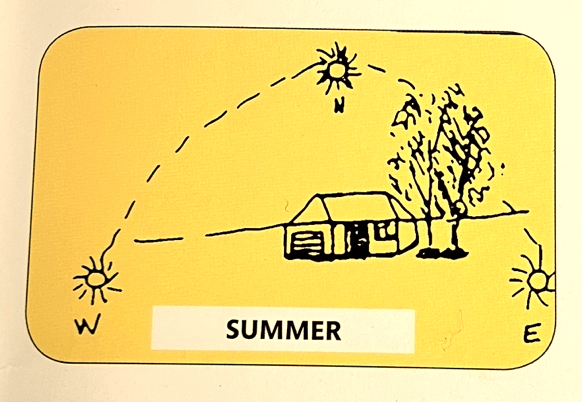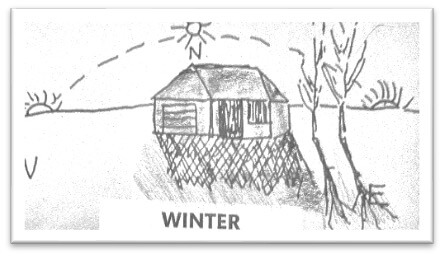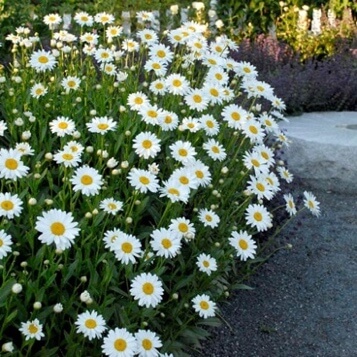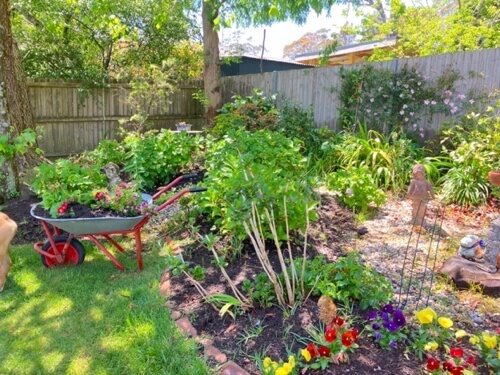I serialise my latest book Garden Design for Everyone Volume 3: continuing with
CHAPTER 2 Developing Your Garden Picture
I present to home owners how to develop ‘the picture’ for their garden’ and to understand the ‘Planting Principles’ when designing your suburban garden.
My overall philosophy of Volume 2 is when designing and planting your garden, plant your garden to make us happy.
- I comment on aspects of the garden
- Time and its effect on the garden owner.
- The garden’s aspect and site.
- Scale and proportion ‘How to divide your garden space’.
- In search of your style.
- How to get your picture right; I write about the garden’s structure: hedges, and pathways.
‘Initiating the right colour for your garden’ with a selection of favourite plants.
Firstly: Look at your “Aspect and site” where does your garden receive the sun, at different times of the year”.

In the summer the sun appears higher in the sky, with shorter shadows.

Winter the sun is lower the sky, the shadows lengthen, particularly on the Southern and Eastern side of the home.
‘Dividing your garden space ’ getting the planning right
In both volumes of Garden Design for Everyone; I emphasised creating separate garden areas by ‘dividing your garden’. Dividing your garden into areas to such as garden beds, pathways, hedges archways must be built too to the right scale and proportion.
To understand this I refer to a simple equation:
‘Looking at the size of something in relation to something else‘
I discuss in Volume 3 Early suburban gardens
In volume 3 I discuss how the suburban garden 20th – 21st century how the Garden Style is ultimately decided by the garden owner who wants to create a certain mood or feeling.
Garden style
Russell Page, in his book Education of a Gardener, suggests that style: ‘is to organise all the elements present and add fresh ones’;
Like Russel Page when I see a new garden with the client I know, I must absorb all that I can, see and compromise their ideas with mine, and suggest new ones.
Garden style is influenced by the style of the house, the climate, surrounding landscape and our imagination. It will set the scene to support your design and your planting.
In my latest book I write on what plants are best suited for your garden this might mean planting meandering or straight pathways:
- My main job: to enhance the client’s ideas, such as these headings mixed and my knowledge of garden design and plants, consider these ideas
- Why do we need to plan
- What is it I want from the space around my home.
- What do I need in my garden
- Outdoor living space, shade.
Part 2 I write on The garden’s decoration. ‘Colour for the garden’
How to develop a garden picture, I take into account:
- Flowering annual plants, these will provide seasonal colour; and help your garden throughout the year
- Some of my favourite Flowering Perennial Plants
All have different types of root systems either: such as thickened or wiry rhizomes


Over the past centuries (since the 14th century) perennials such as seen here have been common place in traditional European and English perennial borders.
Shasta daisy and Foxglove seen here does well over Autumn-Spring in Australian colder climates.
Other perennials well Autumn to Spring in Australian colder regions are Begonia (elephant ears), Anemone (Windflower) Aquilegia, Carnation, Dahlia Salvia.

The mounded shady garden area, here has Polyanthus, Pansies, mixed with Hydrangea.
Finishing off
Early suburban gardens
A survey of suburban garden, and allotments conducted by the ministry of Agriculture in 1944 found in 1939 only 42% of suburban or working class householders had a garden. Compared with 69% of middle class.
However after the second world war, the new towns were planned on the same principles and the area of English land was devoted to gardens, continued to grow. The fashion of building high rise flats from the 1950’s, did not make much difference on the onward march of gardens.
Reference : ‘An economic history of the English garden’ Roderick Floud
- When Developing a garden Time is critical and knowing it’s effect on the garden.
- Understand what effect the passing of time, will have after a couple of years for the growth and maturity of your trees and shrubs.
- Through the passing of time each I recommend homeowners walk through their gardens, and notice with each season their trees and shrubs growing to maturity and prospering.
- Garden Structure is vital (getting the picture right) when designing your own garden.
